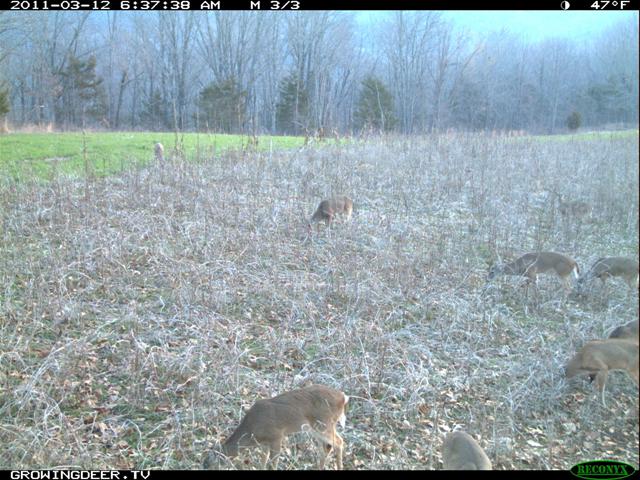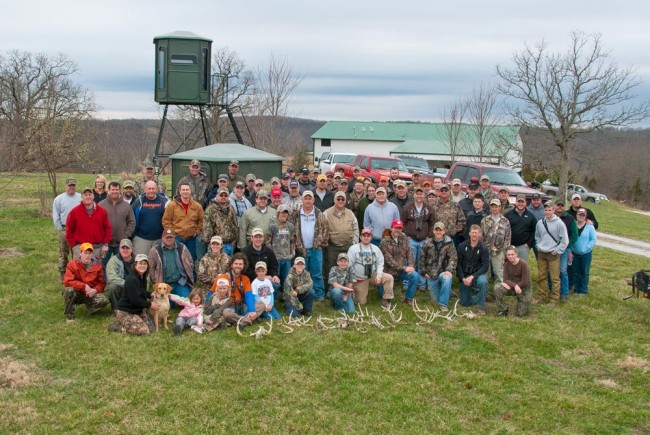Category: Hunting Blog
When to plant spring food plots?
I’ve been getting a lot of questions asking if it is time to plant warm season food plots yet. There are many variables that should be considered before answering this question. I usually use corn as a guide because corn is more tolerant of colder soil and air temperatures that most food plot crops except clover.
Little if any seed germination and seedling growth occurs in soils with temperatures less than 46F. Warmer soil temperatures facilitate seed germination and seedling growth with the optimum being when the soil is a constant 86F. However, drought and heat stress is much more common when the soil temperature is 86F. Therefore corn, soybeans, peas, and most other forage crops should be planted with the soil temperature at 2” to 4” deep at 60F.
However, simply knowing the current soil temperature is not enough to begin planting. That’s because once the seed begins to germinate, a significant change in soil temperature can cause problems. Research shows that a swing of soil temperatures of 27F (soil high temperature-soil low temperature) will significantly affect seed or seedling growth. Seed placed into the ground, yet not emerged, can be injured from a cold period. Seedlings can also have stunted and distorted leaves or may not emerge from the soil.
Given the current conditions and the forecast throughout much of the whitetails’ range for cool-wet weather, the best place for seed this week, if the property you manage is north of the Mason/Dixon line, is probably in the bag.
Growing Deer together,
Grant
Learning from Harvested Critters!
Unless you manage land in an area where the primary land use is commercial ag production, it requires good food plots to produce forage and grain on a year round basis. The corn and soybean rotation in areas where the primary land use is commercial ag production provides a great diet for deer, turkey, and many other wild species. Even though these crops are harvested, the combines spill a bit of grain that provides high quality food through the winter.
However, as combines become more efficient, there is less and less spilled grain available for wildlife. This is why it’s important to plant specifically for wildlife in both areas with and without commercial ag production.
There have been four turkeys harvested so far during 2011 at The Proving Grounds. I checked the crop in three of these turkeys and each of them contained soybean grain! The last was yesterday when my 80 year old father harvested an adult gobbler. It was a thrilling hunt and the real trophy was the time spent with my father. The gobbler and video was a bonus. However, I always want to learn from the harvested critter as much as practical. I call this scouting from the skinning shed!
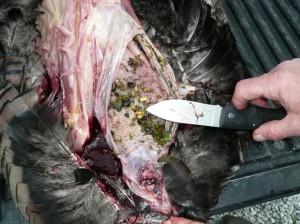
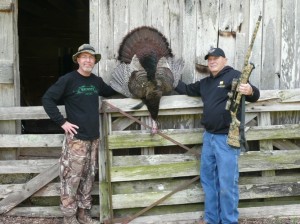
This goes beyond recording weight, spur length, and beard length. One of the most important sources of information from all harvested critters is what’s in their gut (or crop when talking about turkeys). Even though it’s late April and we’ll begin planting Eagle Seed soybeans soon, this turkey had soybeans in its crop. My father harvested this gobbler just after noon, so the crop wasn’t full (he had probably been chasing hens all morning) but it still contained soybeans.
Truly the Eagle Seed beans planted during April and May 2010 are still feeding wildlife at The Proving Grounds a year later. That’s an extreme value! Scouting from the skinning shed also provides me with more confidence on where I should take Tracy, my wife, hunting later this week.
The next time you harvest a critter don’t pass on the opportunity to learn about the local habitat and current hunting information. Sometimes the best scouting occurs without leaving the skinning shed.
Growing Deer together,
Grant
Bag Maps…
It’s snowing and cold in Western Kansas today. In fact, they’ve shut down I-70 throughout most of western Kansas. It is turkey season in that region, but if you plan to hunt there take your warm deer hunting clothes! If you’ve already planted food plots in that area, pray for a rapid warming trend!
It’s cool and very windy at The Proving Grounds today also (no snow thankfully). Although all of my food plots have been sprayed and fertilized, I haven’t planted any crops yet this spring. It’s a good thing as seed that is moist and cold can rot or germinate and then die easily.
This is why I dislike the maps on seed bags that show customers when to plant based on where they live. These data are based on averages over a number of years, and are usually accurate when comparing one region to another. However, they are rarely accurate when considering exactly when to plant at a given location. This is because soil temperature and soil moisture levels usually vary significantly at the same location from year to year.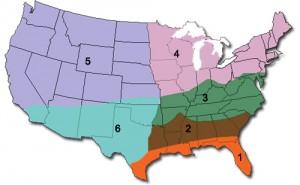
I like to plant each crop as early as practical during the spring. The chances of drought stress (which is caused by a combination of air temperatures and lack of soil moisture) are greater as the temperatures increase. However, each farmer should monitor the local conditions and the weather forecast before deciding when to plant.
Hunters should know this lesson well as they often attempt to use long-term forecasts to plan vacation days to hunt. Then as the date for them to hunt nears, the weather changes and it is 85 degrees and very few deer are moving during daylight hours. The same is true for when to plant food plots. I use the past data (like bag maps) as a guide for when to have the seed and equipment ready to plant. However, I wait until the local conditions are correct before placing valuable seed in the ground. Bag maps are good for general planning, but for site-specific data, they aren’t worth much more than the paper they are printed on.
Growing Deer together,
Grant
Year Round Food Plots: The Magic Bean!
I was part of a panel at a national convention years ago when a member of the audience asked each member of the panel what they thought was the “magic bean” for food plots. Each member of the panel except me offered a suggestion like clover, brassicas, peas, etc. I refused to answer. I agreed with my colleagues that each of the crops they mentioned had good characteristics, but each also had obvious limitations.
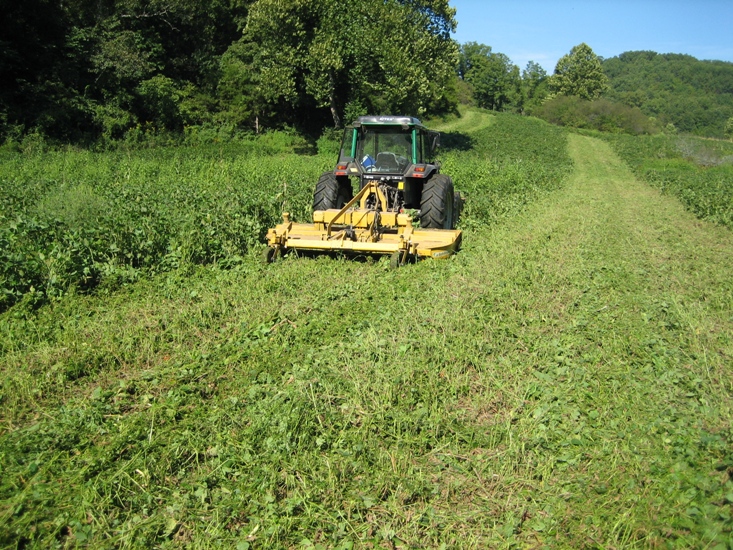 In the decade or so that has passed since that conference I’ve designed, established, maintained and/or evaluated literally 1,000’s of acres of food plots planted in dozens of different crops. Some of those crops proved to be totally unused by deer or the preferred species of game (hence a weed for the food plot mission) or their ability to produce substantial high quality forage was limited, or limited to a very small geographic area.
In the decade or so that has passed since that conference I’ve designed, established, maintained and/or evaluated literally 1,000’s of acres of food plots planted in dozens of different crops. Some of those crops proved to be totally unused by deer or the preferred species of game (hence a weed for the food plot mission) or their ability to produce substantial high quality forage was limited, or limited to a very small geographic area.
During that time I was introduced to forage soybeans. The first plot of forage soybeans I planted was in Mississippi. I remember being amazed at the tonnage of forage. During late August the forage was mowed and I advised the landowner to plant a common winter crop such as wheat. During the next few years I planted or advised more folks to plant forage soybeans as the yield of high quality forage was better than any other crop during the growing season. Years later, I noted that the Eagle Seed forage soybeans were producing a tremendous amount of pods!
A good stand of winter wheat will yield 1,200 to 1,600 pounds of forage per acre. One very poor crop of Eagle Seed forage soybeans (30 bushels per acre) yields 1,800 pounds of high quality grain (soybeans) per acre. I realized that when I mowed the Eagle Seed soybean forage during the early fall, I was mowing down more high quality winter food than what the next crop would likely produce! The beans were already available while I or my clients had to pay for the labor, seed, and fertilizer to gamble to produce another crop.
I’ve now practiced for years a strategy of establishing a high quality crop of forage soybeans and allowing deer and turkey to forage on the vegetation throughout the growing season. Then I leave the crop standing and allow the same critters to consume the seed pods throughout the winter. The crop literally can provide high quality food until it is time to prepare for planting another crop the following spring.
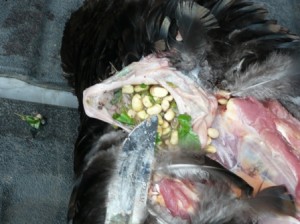
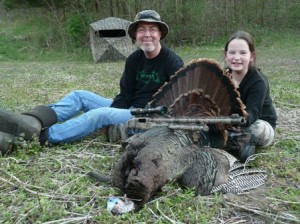 Forage soybeans can produce high quality food for 11 months, from one planting and one expense. I was reminded of the huge advantages of forage soybeans while I was cleaning a gobbler my oldest daughter, Raleigh (age 12), harvested this past weekend. After removing the gobbler’s breast, I opened the crop to see what he had been eating. We call this scouting from the skinning shed. By seeing what critters are currently eating, a hunter can accurately predict where other members of the same species will be consuming the next few days. Raleigh’s turkey was full of soybean seeds! Using this M.R.I. (Most Recent Information), I took my youngest daughter, Rae (age 9) hunting that afternoon. We selected a location overlooking a forage soybean field that had been planted the previous spring. She harvested a mature gobbler there that afternoon.
Forage soybeans can produce high quality food for 11 months, from one planting and one expense. I was reminded of the huge advantages of forage soybeans while I was cleaning a gobbler my oldest daughter, Raleigh (age 12), harvested this past weekend. After removing the gobbler’s breast, I opened the crop to see what he had been eating. We call this scouting from the skinning shed. By seeing what critters are currently eating, a hunter can accurately predict where other members of the same species will be consuming the next few days. Raleigh’s turkey was full of soybean seeds! Using this M.R.I. (Most Recent Information), I took my youngest daughter, Rae (age 9) hunting that afternoon. We selected a location overlooking a forage soybean field that had been planted the previous spring. She harvested a mature gobbler there that afternoon.
By using the technique of scouting from the skinning shed, I was able to confirm that Eagle Seed forage soybeans provide high quality food (forage with high quality protein during the summer and seeds with high quality energy during the winter) at least 11 months throughout the year.
If I was asked the same question at a conference again today, I would have a much better idea of what the “magic bean” is for wildlife food plots. It is a forage soybean that also produces gads of grain.
Growing Deer together,
Grant
Patterning Turkey Shotguns
Youth turkey season begins tomorrow at The Proving Grounds! Traditionally, I take Raleigh (12 years old) before daylight until noon or a tagged turkey and Rae (9 years old) after lunch until dark or a tagged turkey. My mission is purely to share creation with my daughters. I always enjoy time in the woods with both my daughters.
The girls harvesting a tom is my secondary mission. However, I want them and their equipment to be prepared should the opportunity to collect some turkey breast occur. They shoot a 20 gauge pump shotgun that will be loaded with Winchester Game and Field loads with 7.5 shot. I limit the range they shoot to about 20 yards. This combination of yardage and shell selection has proven extremely effective. It has resulted in turkey breast being added to the Woods’ freezer before.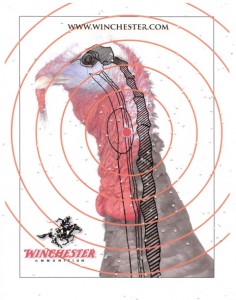
However, we also have experienced a miss. That’s easy to do when using a full choke. It’s also easy to do as hunters (new and experienced) often raise their head from the gun’s stock to gain a better look at the gobbler! I greatly reduced the chances of that happening this year by placing a Nikon TurkeyPro scope on my daughters’ shotgun. The scope helps the girls (and me – I added one to my gun also!) make sure their aim is true. Even without the shooter raising their head, it’s easy to assume the bead is on target when it actually is not. The design of the reticle in the Nikon turkey scope eliminates those assumptions and also allows hunters to accurately estimate yardage to the target.
I actually enjoyed patterning the girls’ and my shotgun today as I knew exactly where I was aiming because of the turkey scope. I doubt the gobblers at The Proving Grounds will be as excited as I am about this addition to our shotguns. We’ll find out tomorrow.
Growing Deer (and turkeys) together,
Grant
Big Bucks are Usually Seen Where the Combines Roam
I was in Kansas turkey hunting last week and visited with a friend there that asked about maximizing the potential of his deer herd. He is a very talented deer manager and an incredible hunter. His stalking skills are by far the best I’ve ever witnessed. He makes me sound like an elephant going through the woods. He lives in an area where combines roam the country side every fall. After getting to know his property, I felt there was one component missing from his deer management practices: standing grain during the winter.
Standing grain provides a great source of digestible carbohydrates to deer and other wildlife. Carbohydrates equate to energy and energy is often the most limited factor in a deer’s diet. Most folks only consider protein when producing crops/habitat management for deer. This is a mistake if the goal is to allow deer to express most of their genetic potential.
Most whitetail hunters realize that most record book bucks are harvested in the agricultural regions of the Midwest. However, they may not realize one of the primary reasons why this trend occurs is because of the quality soils and the excess of grain produced and left available through the winter as combines are not 100% efficient.
The Proving Grounds is located in the very southern portion of Missouri – about 20 miles from the Arkansas border. The world class deer harvested in northern Missouri are direct ancestors from the “dog-sized deer” in southern Missouri, as Missouri primarily restocked deer into the northern (grain producing) counties from the Ozark Mountains of southern Missouri. Many folks wrongly assume there is a genetic difference between the deer north of the Missouri River and the smaller deer in the Ozark Mountains of southern Missouri. The difference is that I’ve never seen a combine in the two counties that split The Proving Grounds.
By producing good quality forage crops during the summer (protein) and grain crops (corn and soybeans) left standing during winter, I’m able to produce northern Missouri quality deer in counties where there has never been a Pope and Young or Boone and Crocket buck recorded (Stone and Taney Counties, Missouri).
The take home message is that folks almost anywhere can allow deer in their neighborhood to express more of their antler growth potential. One of the keys is to provide a good source of energy (grain) through the winter months. Standing soybeans and corn are the least expensive and healthiest method to provide grain to the local wildlife population if you don’t live where combines are a common sight. Even if you live where combines roam, you may be an island where there is no grain, and the local herd may not express much more potential than their distant relatives that don’t ever see a combine.
Growing Deer together,
Grant
Listening Allows Me to Give the Best Counsel
I worked a few properties in South Carolina earlier this week. They were located in the Piedmont of South Carolina where the pine tree is the predominate crop and land cover! These properties were primarily pine forest, with a few acres of food plots. The landowner and his regular guests reported observing deer in the plots on a regular basis. They really enjoyed seeing deer, and really enjoyed consuming the meat and sharing the hunting opportunities with their children and friends.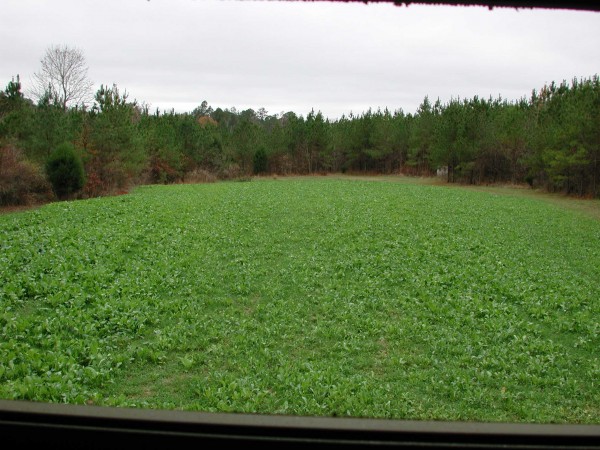
Working this property reminded me that hungry deer are easy to hunt. This is not a new principle. A very successful hunting strategy is to determine a limiting resource (food, cover, or water) and when deer are using that limiting resource. In this case, food was clearly the limiting resource. There were miles and miles of closed canopy pines (both private and industrial owned) and a few interspersed fescue pastures. There were no row crops or other cultivated crops within the likely range of a deer. Hence the primary source of quality and palatable food were the plots on my client’s property. Hence my client knows exactly where to hunt. From experience, he had learned how to approach each plot based on the predicted wind direction to limit disturbance to the local deer herd. As a result he reported seeing multiple deer almost every time he went hunting.
Because he had identified the limited resource and how to hunt it without disturbing deer, he and his guests have been extremely successful at observing and harvesting deer. I warned him that after he implements the habitat improvements I recommended, the quality of the deer should increase, but the quality of his hunting, measured by number of deer observed, may decrease.
I created a plan to thin the timber significantly so there would be sunshine reaching the forest floor. This action paired with a treatment of herbicide and prescribed fire to control hardwood saplings should result in a huge increase in the quality and quantity of native browse production. This means there will be quality food throughout the property, not just in the food plots. In addition, my plan included significantly increasing the acres of food plots and changing what he planted from solely winter annuals to forage soybeans during the summer and winter annuals during the fall (if the deer consumed the beans before they produced pods). It may take a season or two to get the deer density/forage production ratio balanced.
I’m extremely confident if he implements my habitat recommendations, the herd’s quality will increase. However, I’m not sure his observation rate will increase. We will use a trail camera survey to monitor the herd’s population trends. However, monitoring the satisfaction of the client will be through direct observation and conversation. I was confident in my proposal based on detailed and repeated conversations about his deer management and hunting goals and objectives. It is critical to listen to their objectives. Listening often allows me to give the best counsel.
Growing Deer together,
Grant
Finding Skulls vs. Sheds
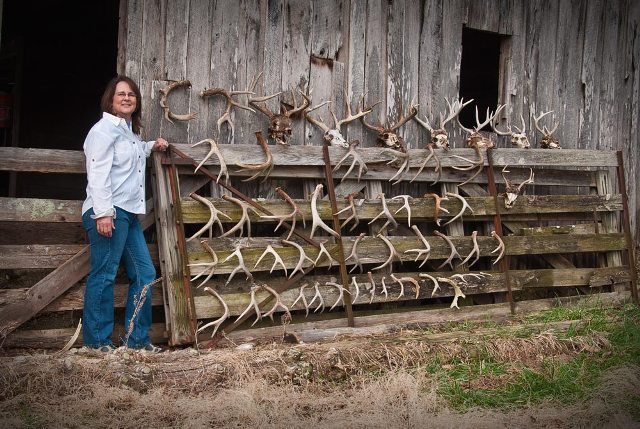 The 2nd Annual Shed Hunt at The Proving Grounds occurred last weekend. We had identified 96 bucks using Reconyx cameras during the 2010-11 season. To date this spring we have found 60 antlers, including seven skulls. That’s almost a third of the antlers that could be on the property! I think that is a huge success considering:
The 2nd Annual Shed Hunt at The Proving Grounds occurred last weekend. We had identified 96 bucks using Reconyx cameras during the 2010-11 season. To date this spring we have found 60 antlers, including seven skulls. That’s almost a third of the antlers that could be on the property! I think that is a huge success considering:
- Some of the bucks are still carrying their antlers based on recent trail camera images.
- Some of the bucks were harvested on neighboring properties.
- Some of the bucks most likely shed on neighboring properties.
- Coyotes and other critters have probably moved or consumed some sheds.
The shed hunt attendees all understood these factors and joined us in celebrating the success of our hunt!! However, there were questions about the number of skulls (7) found. All of the carcasses we found were totally decomposed or consumed. There were only skeletal remains and most of the smaller bones like ribs had been consumed by predators. Therefore there was no evidence as to the cause of death.
There are gads of causes of mortality for deer. In most areas, the most common cause of death is hunting. Predation by coyotes is a close second (and maybe the primary cause of death) in some areas. Deer also are commonly killed by vehicles (not a common cause of death at The Proving Grounds as there is very little road frontage). Deer die as a result of injuries from fighting. Often wounds they receive from fighting become infected. Deer are wounded by hunters and are not recovered.
The bottom line is that non-hunting mortality is a huge factor in deer management. The rate varies from property to property. Good managers learn to account for the non-hunting mortality at their properties and adjust the hunter harvest accordingly. We found 60 total antlers this year at The Proving Grounds, 14 attached to skulls. That means there were 46 sheds (a minimum of 23 bucks, but not all the sheds we found were matches). Taking into account the single sheds we found, it appears we had a 20% non-hunting mortality rate. I expect that is a bit high. Remember, skulls are easier to find than sheds because they are larger and simply easier to observe.
Research from Mississippi State indicated that in the herd they were studying there was about 10% non-hunting mortality annually. That number is probably higher now given that coyote populations are much higher in many portions of the whitetails’ range. So, don’t be surprised if you find about 10% or more skulls. Shed hunting is just another fun tool managers can use to monitor a deer herd.
Growing Deer together,
Grant
Shed Hunt 2011
I really enjoyed the 2nd Annual Shed Hunt! There were fellow deer hunters from 14 states that attended. There were hunting buddies, husband and wives, and families. They came from Texas, Michigan, Indiana, and most states in between. They came from different hunting cultures, different occupations, and hunting experiences. However, they were all deer hunters!! We all laughed and learned together. It was a great event that left me with new friends and ideas.
As I reflect on the great conversations I had this weekend, I’m so saddened when hearing about hunters arguing with each other. White-tailed deer have been extremely abundant throughout most of their range for many years. However, this trend is changing. Several states are now reporting reduced harvest rates. There are several reasons including loss of habitat, loss of hunters, and increased predation. During this era of change in hunters and hunting, it is critical that we deer hunters/managers pull together. We need to identify projects we can unite around and fight for the continued success of white-tailed deer and deer hunters. Silly arguments like whether crossbows should be legal are useless if there are limited deer populations and no deer seasons.
Please remember as deer hunters we have a joint mission of producing healthy herds and providing safe and enjoyable hunting opportunities. Our mission is tough, and may become tougher. There is no room for arguing among our ranks. Our energy is much better spent helping each other.
I believe the best method to stop the arguing is through education. That’s one reason I so enjoy our Shed Hunt and Food Plot Field Day events. It’s a great time for hunters from different cultures to come together on neutral ground and see new techniques and share their knowledge. I really appreciate all the Shed Hunt 2011 attendees that joined my family and me. I hope we shared some useful information with them. I look forward to joining ranks and fighting for our deer herds and for each other. Deer hunters are a family. Good families work to make each member the best they can be.
Growing Deer (and deer hunters) together,
Grant
If It’s Not In The Dirt, It Can’t Get To The Antler
Large antlers are simply a bi-product of healthy, mature bucks. The availability of nutrients in the dirt determines how healthy, drought resistant, productive, etc., plants can be. If the right quantity of nutrients isn’t in the dirt, they can’t feed the plants, and the plants therefore can’t transfer these nutrients to deer. Simply put, if deer don’t consume food produced from good dirt, they can’t produce antlers to their fullest potential.
Given this very simple, but important fact, I’m amazed that every serious deer manager doesn’t collect soil samples and have the soil in their food plots analyzed. The price of having a soil sample analyzed is about $15 per sample. That’s one of the least expensive and most important tools I use as a deer manager.
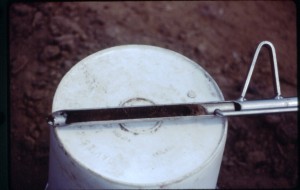 The results of a soil sample include the soil’s pH, and the amount of phosphorous, potassium, and several other trace minerals (depending on the analysis requested). This information is then used to determine how much lime and fertilizer is needed to produce a quality crop.
The results of a soil sample include the soil’s pH, and the amount of phosphorous, potassium, and several other trace minerals (depending on the analysis requested). This information is then used to determine how much lime and fertilizer is needed to produce a quality crop.
However, the information is even more valuable than a generic recommendation! The results will state how much of each element is necessary based on the crop and desired yield you wish to grow!! For example corn requires much more nitrogen than soybeans or clover. To get the best yield and therefore give the deer a better opportunity to express their full antler development potential, it’s critical to apply the appropriate quantity and quality of each element required for each crop. This is exactly where many food plot farmers miss the boat. They collect soil samples and send them to a lab to be analyzed. However, without telling the lab the exact crop or blend of crops to be grown in that plot, the lab is forced to either not provide any recommendations or provide a generic recommendation. This usually results in producing crops that don’t express their full quality or quantity potential, and therefore the deer that consume these crops can’t express their full potential.
I just received the soil test results from Waters Agricultural Laboratories for every food plot at The Proving Grounds, complete with a unique lime and fertilizer recommendation for each crop. Soil tests are a fabulous tool to tune up a deer herd. If it’s not in the dirt, it can’t get to the antler.
Growing Deer together,
Grant



